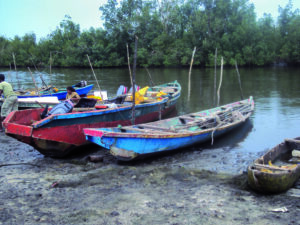Clandestine migrations in the Gulf of Guinea, non-native fishing camps on the Gabonese coast and in the Akanda National Park
By Chancia NYINGUÉMA and Patrick POTTIER
L’Atlas Bleu / Living
Clandestine migration, foreign fisher, Gabonese coast, Akanda National Park
The article describes clandestine maritime migrations at the scale of the Gulf of Guinea, and analyses the relationship with fishing communities practices through the examples of the Gabonese coast and the Akanda National Park. Indeed, the structuring and expansion of artisanal fishing practices in these areas favors the creation and settlement of foreign fishing communities, whose local management is complicated.
Clandestine migrations in the Gulf of Guinea
Illegal migration in the Gulf of Guinea raises numerous sensitive issues, ranging from the monitoring and securing of African coasts and the lack of safety at sea related to the means of transport used by illegal migrants to the questioning of the obligation to safeguard human life at sea.
Most often, the various would-be illegal immigrants travelling by sea, whether moving northward (toward Europe) or southward (to countries such as Cameroon, Equatorial Guinea and Gabon) use makeshift pirogues from West Africa. Although initially used for fishing, for local transport, and for carrying fishermen’s cargo, equipment and catches, fishing pirogues are instead now serving to transport illicit passengers at the expense of the most basic safety conditions (improper and outdated means of transport, overloading). Despite its dangerousness, the sea is still the shortest route to get to destination countries and is the least risky in terms of immigration controls.

Canoe suspected of being used to transport illegal migrants
Moka, 6 July 2010 (Photo C. Nyinguéma)

Fishing canoe duly registered by the Merchant Navy

Different types of fishing canoes at Moka landing stage
Moka, 6 July 2010 (Photo C. Nyinguéma)

Giant canoe built in the Massamboué Camp, which was then requisitioned and destroyed by the local authorities of Cocobeach
April 13, 2012 (Photo Akanda Curator, for the National Agency for National Parks of Gabon)
The shift of African migration toward illegal channels has resulted from a mixture of historical (colonisation in French Equatorial Africa and French West Africa, labour migration, maritime routes of West African fishermen, intra-regional integration) and contemporary factors (poverty, conflicts, globalisation) coupled with the permeability of maritime borders of most African countries bordering the Atlantic. Illegal channels are organised by powerful networks of smugglers who have both continental and maritime connections, also involving former prospective immigrants and increasing numbers of artisanal (small-scale) fishermen.
The prospective migrants have different origins and backgrounds, including both coastal and landlocked countries. In less than ten years, we have witnessed a feminisation of migration, as well as a growing number of children among migrant flows. Despite the type of ‘cargo’ the canoes are carrying (as a smuggler would say) and the dangers faced, the primacy of safeguarding human life at sea does not always take precedence in the face of the various stakes and interests.
Non-native fishing camps on the Gabonese coast and in the Akanda National Park
For almost a quarter of a century, Gabon, like many other countries in the Gulf of Guinea, has been experiencing what can be described today as fishing colonisation. This manifests itself as a large-scale occupation of the coast by artisanal fishing communities, from West Africa in this case. These different communities evolve in poorly accessible sites. It is usually difficult to access these camps, especially for the various authorities in charge of fishing, the environment and immigration. Many are mono-ethnic and predominantly English-speaking, especially because of Nigerian and Ghanaian fishermen. Groups from Benin and Senegal are also found here, as well as a few rare mixed camps.

Nigerian fishing camp on Île Nendé

Entrance banner of the Akanda National Park on Île Nendé
However, the existence of different communities raises questions about the legality of their presence, how difficult it is to know their numbers, their equipment and catches and, especially, their known association with the phenomenon of illegal immigration by sea.
The practice of artisanal fishing through the search for fishing resources has led to the migration of numerous fishermen to areas where they can fish. However, with the integration of seafarers into illegal migrant networks and channels, the question arises as to whether they are fishing to migrate or migrating to fish.
The media coverage of the ‘busts’ made by the French border police (DCPAF) and the French Navy involving boarding canoes loaded with illicit passengers, making arrests on the outskirts of camps of undocumented migrants or rescuing shipwreck survivors, means that certain authorities (shipping companies, national police) routinely stigmatise these fishing communities. It seems that there is a growing disinterest in a situation described as a ‘massive influx’, and which is difficult to manage from a logistical, diplomatic, legal (respect for human rights) and financial (taxpayer’s money) in terms of helping, welcoming or repatriating migrants, often facing countries of origin that refuse to cooperate.
The fact that fishermen and their families have almost complete upstream and downstream control in the artisanal maritime fishing industry (ranging from fishing to ancillary activities, i.e., scaling, processing and fish trade), which moreover is mostly informal, means that the sector can be considered an ethno-business.
The combination of these factors has sometimes led the authorities to react in a drastic way: violent and unannounced raids, partial or total destruction of camps, evictions and expulsions.
This situation illustrates the extreme vulnerability of these non-native populations living in or close to the National Park. It is a reminder of the obvious need to regulate a rapidly growing economic activity that, even though it is unofficial and illegal, generates wealth as it is a part of the local economy. From this point of view, one of the priorities for the future must be to clarify the status of these artisanal fishers.








Leave A Comment